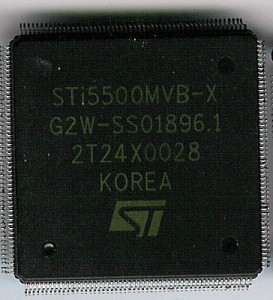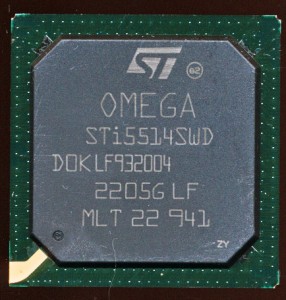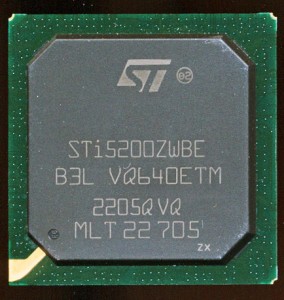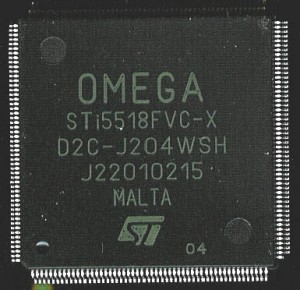The End of the Omega
In January ST announced that they would be exiting the Digital Set Top Box (STB) market. This is a market that they arguably led for the last 20 years, and one that really began with their Omega processor in 1997. The ST Omega processor line, beginning with the STi5500 powered set top boxes, for cable companies, satellite companies, and DVR’s as well as other TV connected devices. Open up a satellite TV receiver from the last 20 years and you are very likely to find a STi Omega chipset.
The STi5500 was the beginning, and interestingly at its core was a ST20 processor, based on the Inmos Transputer (which ST now owned) from the late 1980’s. The Transputer was meant to revolutionize computing, making processors so cheap, that they could be embedded into pretty much any other logic device, what today we call an SoC, but in 1985, was a novel idea. At the time it didn’t really succeed, but ended up seeing its intended use 10+ years later in the Omega. In the 1980s the Transputer saw speeds of up to 30MHz, int he STi5500 it ran at 50MHz with 2K of I-cache + 2K of Data Cache as well as 2K of SRAM that could be used as data cache.
In the early 2000s the Omega was upgraded to a faster ST20 core, eventually hitting 243MHz in the STi5100, now with the caches increased to 8K each, as well as 8K of SRAM. This was getting to be the limit of the ST20 Transputer core. ST needed a core that could support higher speeds running such things as Java and Windows CE amongst other things, as well as support the higher resolutions and audio quality requirements.
ST handled this is in two entirely different ways. First they licensed the SH-4 32-bit RISC core from Hitachi, a rather surprising move but STBs was not a market Hitachi was in, so it was in both companies best interest. ST also was working on their own new core to replace the ST20, and they had help, from a very surprising partner.
The replacement for the ST20 was to be the ST200, a 32-bit VLIW processor that was jointly developed with HP Labs as the Lx Architecture. It had a 7 stage pipeline (compared to the 3-stages of the ST20) and had 4 integer units, as well as a pair of 32 bit multipliers. ST used this core in the STi53xx and STi5524 processors, clocked at 300-333MHz with 32K caches. The ST200 (and its ST231 implementation) was going to see its widest use though in the Omega2.
The Omega2 processors were based on the 5-stage ST40 cores (40-2xx and 40-300), which was ST’s licensed implementation of the Hitachi SH-4. The first versions (such as the STi5200) ran at 266MHz with 16K of I-cache and 32K of Data cache. These cores included a full MMU and FPU. This rapidly increased to 450MHz with 32K caches. The ST231 core continues to be used as well in the same chip, with one ST231 being used for audio, and one for video, making the Omega2 a triple-core SoC.
The Chart below shows a summary of the STi set top box processors, up until the change over to the STiH line. ST made a version for nearly every market, and price point imaginable. Some only vary in features such as added security (useful in pay satellite applications) or in graphics support, and OS support. Others of course have more/less cache and higher performance CPU cores.
| Model | Core | Speed (MHz) | Caches K (D/I/SRAM) | Aux Cores |
| ST20 Transputer Based | ||||
| STi5500 | ST20C2 | 50 | 2/2/2 | None |
| STi5505 | ST20C2 | 50 | 2/2/2 | None |
| STi5510 | ST20C2 | 60 | 2/2/4 | None |
| STi5512 | ST20C2 | 60 | 2/2/4 | None |
| STi5514 | ST20 | 180 | 8/8/8 | None |
| STi5516 | ST20 | 180 | 8/8/8 | None |
| STi5517 | ST20 | 180 | 8/8/8 | None |
| STi5518 | ST20C2+ | 81 | 2/2/4 | None |
| STi5100 | ST20 | 243 | 8/8/4 | None |
| STi5105 | ST20 | 200 | 4/4/2 | None |
| STi5107 | ST20 | 166 | 4/4/2 | None |
| ST200 VLIW Based | ||||
| STx5524 | ST200 | 300 | 32/32 | |
| STi5300 | ST230 | 333 | 32/32 | |
| STi5301 | ST230 | 333 | 32/32 | |
| Hitachi SH-4 Based | ||||
| STi5200 | ST40 | 266 | 16/32 | 2x 400MHz ST231 |
| STi5202 | ST40 | 266 | 16/32 | 2x 400MHz ST231 |
| STi5205 | ST40-300 | 450 | 32/32 | 2X ST231 |
| STi5206 | ST40-300 | 450 | 32/32 | 2x ST231 |
| STi5211 | ST40-300 | 450 | 32/32 | 2x 450MHz ST231 |
| STi7100 | ST40 | 266 | 16/32 | 2x 400MHz ST231 |
| STi7101 | ST40 | 266 | 16/32 | 2X ST231 |
| STi7105 | ST40-300 | 450 | 32/32 | 2X ST231 |
| STi7106 | ST40-300 | 450 | 32/32 | 2X ST231 |
| STi7108 | ST40-300 | Dual 500 | 32/32 + 256K L2 | 3X ST231 |
| STi7109 | ST40-202 | 266 | 16/32 | 2X ST231 |
| STi7111 | ST40-300 | 450 | 32/32 | 2x 450MHz ST231 |
| STi7200 | ST40-210 | 320 | 16/32 | 4x ST231 |
*STi7xxx are HD video version of STi5xxx designs
The Omega2 reached its peak with the STi7100 which uses a dual core 500MHz ST40 with 256k of L2 cache, and 3 ST231 cores for additional processing. In addition, it has a Mali graphics core by ARM.
The Omega and Omega2 were replaced by the STiH200 ST40 based, and STiH300 ARM based processors. These were great processors, but the STB market has been shrinking, the features provided by a set top box are rapidly shifting to being included inside the TV itself, or based entirely in the cloud.
ST will transition much of those who worked on these to their IoT and automotive divisions, both of which are rapidly growing. And thus the end of the Omega will likely become the beginning of a future car’s infotainment system, or a refrigerators internet connection.





